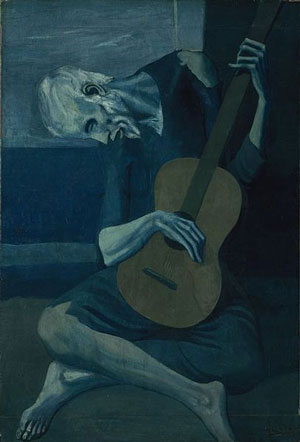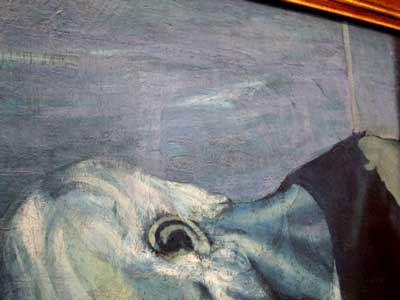By Reid Rosefelt
When I was a teenager growing up in a tiny Wisconsin town, Chicago was the Big City, and The Art Institute was the only major museum I had been to in my life. My favorite gallery there was the Helen Birch Bartlett Memorial Collection. I could gaze at the huge canvas of Georges Seurat’s “A Sunday on La Grande Jatte,” as well as Toulouse-Lautrec’s “At the Moulin Rouge,” van Gogh’s “The Room,” and many others by such masters as Gauguin, Rousseau, Modigliani, Cézanne, and Matisse. For me, these paintings were celebrities. Being in the room with them was as thrilling as being in the same room with Bob Dylan or Jack Nicholson.
 Despite all the riches, I found myself drawn to a single painting: Picasso’s “The Old Guitarist” an iconic image from his Blue Period. I loved the painting, but my real fascination was with something hidden underneath it. Behind the old man’s blue head I could see the face of a beautiful woman, her lips resting behind his ear, her neck flowing out from the Platysma muscle in his neck, and her ghostly eyes burning into my own. Her whole face and hair were completely visible, and I could see the shadow of two legs transecting his shin. Nobody pointed her out to me–I discovered her all by myself. I doubted anybody in the room knew she was there or they wouldn’t have sprinted past the painting like Anna Karina, Sami Frey and Claude Brasseur did in the Louvre in Godard’s “Bande à Part.”
Despite all the riches, I found myself drawn to a single painting: Picasso’s “The Old Guitarist” an iconic image from his Blue Period. I loved the painting, but my real fascination was with something hidden underneath it. Behind the old man’s blue head I could see the face of a beautiful woman, her lips resting behind his ear, her neck flowing out from the Platysma muscle in his neck, and her ghostly eyes burning into my own. Her whole face and hair were completely visible, and I could see the shadow of two legs transecting his shin. Nobody pointed her out to me–I discovered her all by myself. I doubted anybody in the room knew she was there or they wouldn’t have sprinted past the painting like Anna Karina, Sami Frey and Claude Brasseur did in the Louvre in Godard’s “Bande à Part.”
I was obsessed with my melancholy blue girlfriend (of course she would have been blue). Who was she? The Blue Period was a time when Picasso was practically starving in Spain. She was probably some poor woman who agreed to model for him for free. He probably slept with her. That was how he rolled.

Detail from “Daydream Tourist” blog
I was aware that in those days Picasso regularly reused canvases. Canvas was expensive. Still, I suspected that when he was painting the old man he could still see my blue girlfriend so I thought it wasn’t unreasonable to imagine that some lines in her drawing meshed with the old man’s lines. Maybe they were artistically bonded, whether or not that was Picasso’s intention. The old man’s head was bent over at a 90 degree angle from his body, parallel to the floor. My love held her body ramrod straight. The painting gives out a powerful feeling of melancholy, but also reverie–he is lost in his thoughts. As a guitarist I can tell you that even if the guitar had strings, he wouldn’t be playing it. He’s just holding it. I let my mind wander. Maybe my amour was somebody from the old man’s past? A woman he loved and lost? A wife? A daughter? As he’s definitely suffering from malnutrition, maybe the girl passed from one of the blights of poverty, like illness. Thinking about the girl made me more interested in him and in the painting than I would have otherwise. And I actually had to be present both physically and mentally in order to have this experience. There’s no way you could pick out the girl from a small art book illustration.
What does this story have to do with movie marketing?
Read the rest of the post HERE
 Reid Rosefelt blogs and coaches filmmakers & artists about how to market their films using social media, and lectures frequently on the topic. His credits as a film publicist include “Stranger Than Paradise,” “Crouching Tiger, Hidden Dragon, and “Precious.”
Reid Rosefelt blogs and coaches filmmakers & artists about how to market their films using social media, and lectures frequently on the topic. His credits as a film publicist include “Stranger Than Paradise,” “Crouching Tiger, Hidden Dragon, and “Precious.”
His blog is reidrosefelt.com and his Pinterest Page Social Media for Filmmakers was named first on IndieWire’s list of “10 Pinterest Boards Filmmakers Should be Following.”





